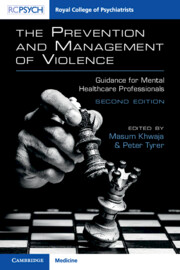Book contents
- The Prevention and Management of Violence
- The Prevention and Management of Violence
- Copyright page
- Dedication
- Contents
- Contributors
- Preface
- Abbreviations
- Section 1 General Aspects of Management
- Introduction to Section 1
- Chapter 1 The Need for a Common Set of Guidelines
- Chapter 2 Legislation Relevant to the Management of Violence by Persons With Mental Disorders
- Chapter 3 Protection and Safeguarding of Vulnerable Adults and Children Exposed to Violence
- Chapter 4 Anticipation and Reduction of Violence: Implications of the NICE 2015 Guideline
- Chapter 5 Post-Incident Management
- Section 2 Medical and Psychological Intervention
- Section 3 Violence in Different Settings
- Section 4 Management in Other Groups
- Section 5 Violence and Society
- Section 6 Engagement and Understanding
- Index
- References
Chapter 5 - Post-Incident Management
from Section 1 - General Aspects of Management
Published online by Cambridge University Press: 09 May 2023
- The Prevention and Management of Violence
- The Prevention and Management of Violence
- Copyright page
- Dedication
- Contents
- Contributors
- Preface
- Abbreviations
- Section 1 General Aspects of Management
- Introduction to Section 1
- Chapter 1 The Need for a Common Set of Guidelines
- Chapter 2 Legislation Relevant to the Management of Violence by Persons With Mental Disorders
- Chapter 3 Protection and Safeguarding of Vulnerable Adults and Children Exposed to Violence
- Chapter 4 Anticipation and Reduction of Violence: Implications of the NICE 2015 Guideline
- Chapter 5 Post-Incident Management
- Section 2 Medical and Psychological Intervention
- Section 3 Violence in Different Settings
- Section 4 Management in Other Groups
- Section 5 Violence and Society
- Section 6 Engagement and Understanding
- Index
- References
Summary
Incidents involving violence and aggression are unfortunately common on mental health wards and in community settings. These incidents can lead to emotional distress, mental health issues and, in certain circumstances, moral injury. Serious incidents of aggression are, however, critical learning junctures from which improvements in clinical care should be driven. Yet if staff feel under threat or unsupported by leaders, they may not engage in the process. Clinical leaders should therefore create clinical teams which are psychologically safe, so that learning can take place as a core component of team activity. How to create such cultures is described, wherein leaders play a critical role. Staff support, after an incident, must be part of the learning process, for no traumatised team can learn effectively. Post-incident reviews should form a key component in this learning process. A team-based seven-step process of incident review is outlined, which does require skillful delivery. In some instances, a formal investigatory review might be needed, as well as prosecution of perpetrators, and brief guidance is given on this.
Keywords
- Type
- Chapter
- Information
- The Prevention and Management of ViolenceGuidance for Mental Healthcare Professionals, pp. 63 - 74Publisher: Cambridge University PressPrint publication year: 2023



